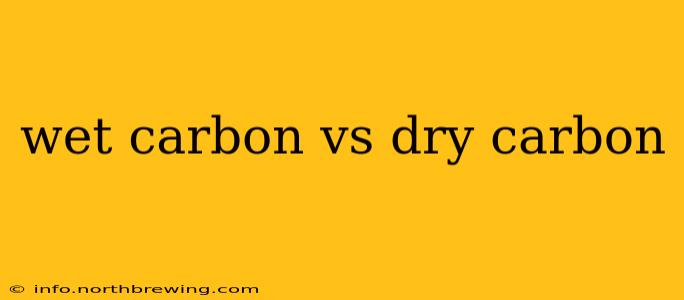Carbon fiber composites are renowned for their exceptional strength-to-weight ratio, making them ideal for high-performance applications in various industries, from aerospace and automotive to sporting goods. However, within the world of carbon fiber, there's a crucial distinction: wet carbon versus dry carbon. Understanding this difference is key to appreciating the nuances of these advanced materials and selecting the right one for a given application.
What is Wet Carbon?
Wet carbon refers to a carbon fiber composite manufacturing process where the carbon fiber fabric is impregnated with resin during the layup process. The resin is typically applied in liquid form, either by hand or using automated systems. This wet layup method allows for intricate shapes and designs to be created, but it also introduces some challenges. Because the resin is added during the layup, achieving consistent resin distribution and void-free parts can be more difficult, requiring significant expertise and potentially leading to imperfections. The curing process, which hardens the resin, often involves heat and pressure in an autoclave.
Advantages of Wet Carbon:
- Versatility: Allows for complex shapes and designs.
- Cost-effective (for certain applications): Can be relatively inexpensive for smaller-scale production.
- Good strength-to-weight ratio: Still boasts excellent mechanical properties.
Disadvantages of Wet Carbon:
- Labor-intensive: Can require significant manual labor, particularly for complex parts.
- Potential for imperfections: Achieving consistent resin distribution can be challenging, leading to possible voids and variations in strength.
- Longer curing times: Autoclave curing typically requires extended periods.
What is Dry Carbon?
Dry carbon, conversely, utilizes pre-preg carbon fiber. "Pre-preg" stands for "pre-impregnated," meaning the carbon fiber fabric is already saturated with resin at the factory, creating a semi-cured sheet ready for layup. This approach offers several advantages. The resin is already evenly distributed, minimizing the risk of voids and improving consistency. The manufacturing process is often faster and more precise, leading to better quality control.
Advantages of Dry Carbon:
- Higher quality and consistency: Pre-impregnation ensures even resin distribution and reduces imperfections.
- Faster manufacturing: Less labor-intensive, leading to quicker production times.
- Improved mechanical properties: Often results in stronger and stiffer parts due to less resin variation.
- Precise control: Enables better control over fiber orientation and layup for optimized performance.
Disadvantages of Dry Carbon:
- Higher cost: Pre-preg carbon fiber is typically more expensive than standard carbon fiber.
- Less design flexibility: Requires more careful planning and design to utilize pre-preg efficiently.
- Shorter shelf life: Pre-preg materials have a limited shelf life due to resin curing.
What's the Difference in Strength and Weight?
While both wet and dry carbon can achieve excellent strength-to-weight ratios, dry carbon generally produces parts with slightly better mechanical properties due to the more precise resin distribution and fiber alignment. The absence of voids and consistent resin content results in a stronger and stiffer finished product. The weight difference can be subtle and often depends on the specific materials and manufacturing processes employed. However, the improved consistency of dry carbon often leads to more predictable performance.
Which is Better: Wet Carbon or Dry Carbon?
There is no single "better" option; the ideal choice depends entirely on the specific application and priorities.
-
Wet carbon is a suitable choice when intricate shapes are needed, cost is a primary concern, and perfection isn't paramount. Smaller-scale projects or applications where some variations in strength are acceptable might benefit from this method.
-
Dry carbon is preferred when high precision, superior mechanical properties, and consistent quality are crucial. Applications requiring high performance, such as aerospace components or high-end sporting goods, often utilize dry carbon due to its superior consistency and strength.
How are Wet and Dry Carbon Used?
Both methods find their place in various industries:
- Wet carbon: Found in some automotive parts, boat hulls, and less demanding applications where cost-effectiveness is a major factor.
- Dry carbon: Commonly used in high-performance automotive parts (like Formula 1 cars), aerospace components, high-end bicycles, and other applications demanding superior strength and precision.
By understanding the strengths and weaknesses of each method, manufacturers can select the appropriate process to achieve the desired properties and performance characteristics for their specific product.
